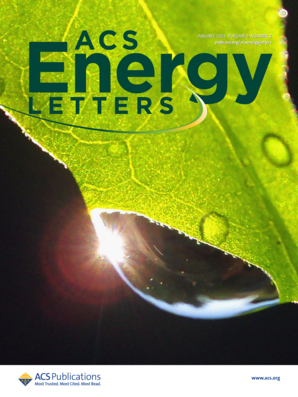In Situ Engineering of a Multifunctional Cathode–Electrolyte Interphase for Advanced Sodium-Ion Batteries
IF 19.3
1区 材料科学
Q1 CHEMISTRY, PHYSICAL
引用次数: 0
Abstract
Layered transition metal oxides have been considered promising cathode candidates for sodium-ion batteries due to their exceptional specific capacity and tunable composition. Nevertheless, their commercialization faces critical challenges, including irreversible phase transitions, hygroscopic degradation, and thermal runaway risks. To address these limitations, we propose a strategy for the in situ construction of an artificial cathode–electrolyte interphase (CEI) layer, which facilitates rapid Na+ diffusion kinetics and suppresses detrimental interfacial side reactions. The modified Na2/3Ni1/3Mn2/3O2 electrode delivers a remarkable reversible capacity of 150 mAh g–1 at 0.1 C while maintaining 84% capacity retention over 200 cycles at 1 C (vs 67% for pristine). Notably, the CEI-modified cathode exhibits significant air tolerance, retaining 96% of initial capacity after 7-day ambient exposure. Furthermore, thermal analysis confirms enhanced thermal stability of the battery, effectively mitigating safety concerns. The work establishes a universal paradigm for stabilizing electrode materials, providing critical insights for developing robust sodium-ion battery systems.

先进钠离子电池多功能阴极-电解质界面的原位工程研究
层状过渡金属氧化物由于其特殊的比容量和可调的成分而被认为是钠离子电池极有前途的阴极候选者。然而,它们的商业化面临着严峻的挑战,包括不可逆相变、吸湿性降解和热失控风险。为了解决这些限制,我们提出了一种原位构建人工阴极-电解质界面(CEI)层的策略,该策略促进了Na+的快速扩散动力学并抑制了有害的界面副反应。改进的Na2/3Ni1/3Mn2/3O2电极在0.1 C下提供150 mAh g-1的显著可逆容量,同时在1 C下200次循环保持84%的容量保持率(原始状态为67%)。值得注意的是,cei修饰的阴极表现出显著的空气耐受性,在环境暴露7天后保持了96%的初始容量。此外,热分析证实了电池的热稳定性增强,有效减轻了安全问题。这项工作为稳定电极材料建立了一个通用的范例,为开发强大的钠离子电池系统提供了重要的见解。
本文章由计算机程序翻译,如有差异,请以英文原文为准。
求助全文
约1分钟内获得全文
求助全文
来源期刊

ACS Energy Letters
Energy-Renewable Energy, Sustainability and the Environment
CiteScore
31.20
自引率
5.00%
发文量
469
审稿时长
1 months
期刊介绍:
ACS Energy Letters is a monthly journal that publishes papers reporting new scientific advances in energy research. The journal focuses on topics that are of interest to scientists working in the fundamental and applied sciences. Rapid publication is a central criterion for acceptance, and the journal is known for its quick publication times, with an average of 4-6 weeks from submission to web publication in As Soon As Publishable format.
ACS Energy Letters is ranked as the number one journal in the Web of Science Electrochemistry category. It also ranks within the top 10 journals for Physical Chemistry, Energy & Fuels, and Nanoscience & Nanotechnology.
The journal offers several types of articles, including Letters, Energy Express, Perspectives, Reviews, Editorials, Viewpoints and Energy Focus. Additionally, authors have the option to submit videos that summarize or support the information presented in a Perspective or Review article, which can be highlighted on the journal's website. ACS Energy Letters is abstracted and indexed in Chemical Abstracts Service/SciFinder, EBSCO-summon, PubMed, Web of Science, Scopus and Portico.
 求助内容:
求助内容: 应助结果提醒方式:
应助结果提醒方式:


